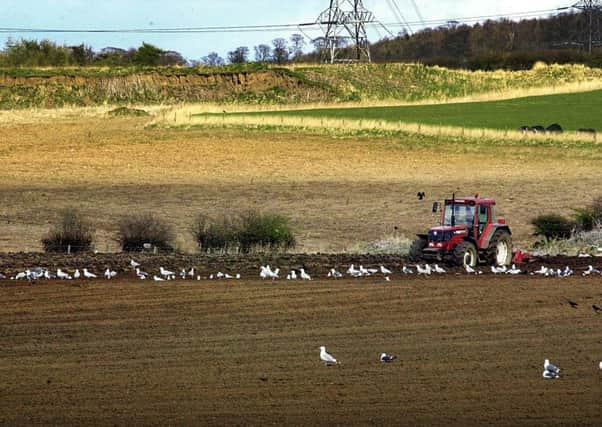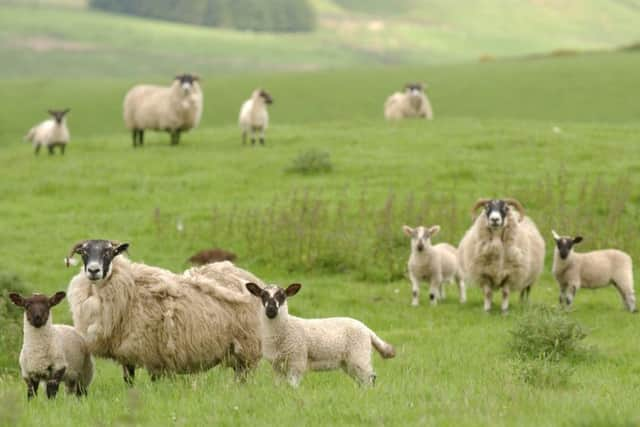Health of rural economy paints mixed picture


A look at the health of Scotland’s rural economy paints a mixed picture. There’s no denying there are, have been and will still be challenges.
Brexit poses questions over subsidies, the housing crisis is being felt in rural areas every bit as much as it is in cities – if not more – and a lack of jobs is forcing young people to move away in search of work.
Advertisement
Hide AdAdvertisement
Hide AdAdd to that the Scottish Land Reform Act, the effects of which are now being keenly felt by landowners and tenants, and the struggles faced by dairy farmers – dairy farms in Scotland reached a new historic low of 957 in January following the loss of 17 farms in 2016 – and you could be forgiven for thinking the future looks bleak.


But this is a situation where the saying “in every challenge there lies opportunity” comes into play.
There is a lot to be positive about with 80 per cent of Scotland’s rural communities already economically active and rural business closure rates lower than the rest of the UK.
According to Steve Westbrook, director of the Economic Intelligence Unit at the University of the Highlands and Islands, it’s up to each individual community to take action and enhance the areas where improvement is needed most.
“Some places will be thriving, other places will be struggling and that will probably always be the case,” says Westbrook.


“My view is that most places – both urban and rural – have to increasingly take the future into their own hands.
“You have an economy that has fewer and fewer medium-sized businesses that are going to support local areas.
“You also have public sector spending cuts that are going to mean rural areas have to provide more and more of their own services.
Advertisement
Hide AdAdvertisement
Hide Ad“Areas need to look at things like how they can get more tourists in the area and get them spending more; can they put a turbine up that then generates income?”
The Borders introduced its Economic Strategy 2023 in 2013 with the aim of becoming one of the best performing and most productive economies in Scotland.
The opening of the Borders Railway in 2015, which brought the first passenger services since 1969, was certainly a step in the right direction.
The region is already experiencing economic and population growth, commercial and tourism development, a diversifying business base and a new demand for learning and skills.
Westbrook points to the West Coast where residents on the isle of Gigha took matters into their own hands.
While there have been bumps in the road, Gigha has been heralded as an example of successful community ownership which has seen the population grow from 100 to 170.
The “right kind” of population growth is crucial, according to Westbrook, as is the continued improvement of connectivity.
“The main challenge in rural Scotland is getting enough young people in,” he says. “That’s people who otherwise would have left the area because there wasn’t any work for them.
Advertisement
Hide AdAdvertisement
Hide Ad“Increasingly, people can work from home and if they have broadband then living in a nice rural area can attract people.
“Connectivity in rural areas is improving. There is quite a lot of Scottish Government and UK government funding going into getting fibre connections to provide broadband right the way around rural areas.
“If you take the Highlands and Islands, over the next four to five years, it might be that 85 per cent of houses are connected up to good broadband.”
The difficulty is getting that to the remaining 15 per cent where, Westbrook says, it may simply not be cost effective to install a fibre internet connection for just one or two properties in a remote location.
Appropriate and affordable housing is required if young families are to settle in rural communities and there are schemes in place to support the construction of suitable homes.
The Rural Housing Fund (RHF) was launched in 2016 with a pot of £25 million (over three years from 2016-2019) to be allocated to rural housing, while the Islands Housing Fund has a £5m pot for development on remote Scottish islands.
A grant of £27,000 from the RHF – the first to be awarded after its launch last year – helped to finance the development of two community-built family homes on Mull.
The land for the properties was purchased by the Ulva School Community Association and the Mull and Iona Community Trust with the support of the local community when, in 2010, the primary school was threatened with closure.
Advertisement
Hide AdAdvertisement
Hide AdWith signs of recovery in the housing market, the demand for UK timber is strong. This is reflected in the health of the forestry industry which has been described as Scotland’s “hidden success story”.
It’s a sector which saw a 50 per cent increase in direct employment during the economic downturn and is worth £1 billion to the Scottish economy, but it doesn’t shout about it.
Certainly forestry, like most industries, has had its challenges – namely a lack of commercial planting – but by looking at ways to promote the combination of forestry and farming, Scotland is taking a big step towards a bright future for the sector.
In May, rural economy secretary Fergus Ewing announced the introduction of the Forestry and Land Management (Scotland) Bill, with the aim of providing a modern legislative framework to develop, support and regulate the sector in Scotland.
The announcement was seen as a vital step towards encouraging investment and meeting the government’s forestry targets.
According to Savills’ UK Forestry Market 2017 report, one of the most buoyant market sectors in 2016 was the purchase of agricultural land for new woodland creation, driven in part by a shortage of quality stocked woodland property on the market.
“We think there will be greater investment in forestry,” says Jonathan Henson, head of rural at Savills in Scotland.
“The fundamental economics of forestry have never been so exciting in all my career. Over the last ten to 15 years there has been substantial inward investment in the UK in sawmilling and processing.
Advertisement
Hide AdAdvertisement
Hide Ad“There is recovery in the housing market and those are going to be timber-framed houses, therefore the use of timber is definitely going to rise.
“Around 80 per cent of timber is imported into the UK which means that the future for the forestry sector is very bright. We are predicting continued growth in UK forest values for the next five years.”
Savills’ GB Agricultural Land survey 2017 – the first of its kind – showed a 3 per cent drop in the value of Scottish agricultural land, but considering the political and economic developments of 2016, the farmland market has proved it is nothing if not resilient.
Since 2007, land values have soared by 160 per cent and forecasts suggest they will increase by a further 5.5 per cent by 2021.
That said, significant uncertainty remains with regard to Brexit, and nowhere more so than in the agricultural sector where the focus, according to Henson, needs to be on increasing production.
“Brexit means we think there will be about 30 to 40 per cent less direct subsidy around,” says Henson.
“With a 30 per cent reduction, it really means people need to keep their focus on increasing production.
He adds: “For those people that are innovative and make best use of technology, it could be quite an exciting time.”
Advertisement
Hide AdAdvertisement
Hide AdHenson points out that the reliance on the agricultural sector has significantly reduced as landowners diversify and look to generate income in other areas.
“The percentage relied upon in terms of estate income from the agricultural sector was about 37 per cent in 2016 down from about 49 per cent in 2000,” he says.
“That means they are less reliant on agriculture. That’s not because the income or revenues have become a lot less – it’s because they have diversified into residential properties, renewable energy and forestry. To some extent, they are better prepared to suffer the downturn that is going to come from the agricultural sector in terms of Brexit.”
That word “diversification” is becoming something of a theme when it comes to looking at ways Scotland’s rural economies can grow and thrive. Westbrook, too, says families living in rural areas will have to diversify, in some cases by focusing on bringing money into their communities through tourism.
“Looking at the future of rural Scotland, it is going to be necessary for people to do a range of jobs,” says Westbrook.
“To have one job, for example working on a farm or working in a local engineering business, those opportunities are getting less and less.
“What is now needed in rural areas is for families to be able to do a range of things, including bringing tourists in.
“Tourism has been growing quite well in the last couple of years, mainly because of the exchange rate.
Advertisement
Hide AdAdvertisement
Hide Ad“It’s more expensive going abroad so Scotland has definitely benefited from that in the last two years and that could continue.
“Rural areas in general should survive. It’s about the age structure and how self-supporting they can be economically.”
So there are opportunities in the tourist market. There are opportunities in terms of producers tapping into Scotland Food & Drink’s “Ambition 2030” which aims to double turnover to reach £30bn by 2030.
There are opportunities for farmers who are willing to embrace innovation and technology, and there are opportunities for communities that are taking action to improve issues such as poor connectivity, an ageing population and a lack of affordable housing.
Henson sums up the situation succinctly: “There are massive challenges ahead but with those challenges there are some massive opportunities for people who are innovative.”